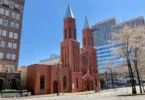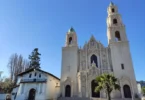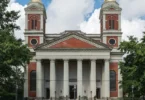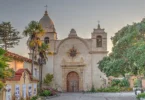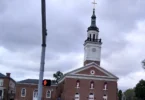Introduction
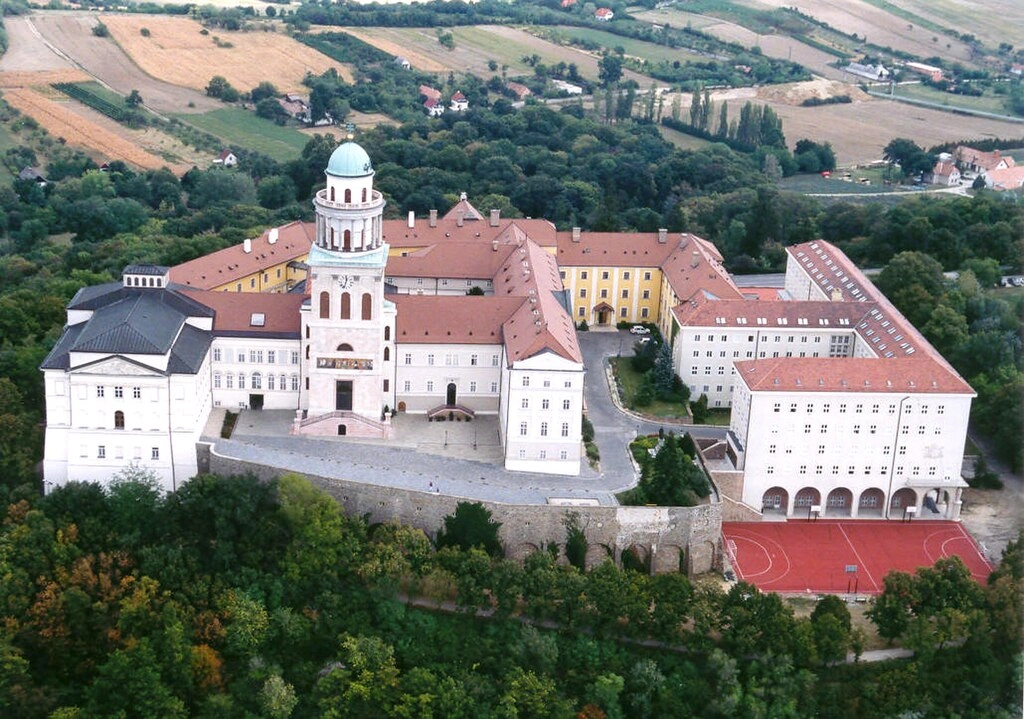
The Benedictine Pannonhalma Archabbey or Territorial Abbey of Saint Martin on Mount Pannonhalma (lat. Archiabbatia or Abbatia Territorialis Sancti Martini in Monte Pannoniae) is a medieval building in Pannonhalma and one of the oldest historical monuments in Hungary. Founded in 996, it is located near the town, on top of a hill (282 m). Saint Martin of Tours is believed to have been born at the foot of this hill, hence its former name, Mount of Saint Martin (Hungarian: Márton-hegy), from which the monastery occasionally took the alternative name of Márton-hegyi Apátság. It is the second largest territorial abbey in the world, after the one in Monte Cassino. Its sights include the Basilica with the Crypt (built in the 13th century), the Cloisters, the monumental Library with 400,000 volumes, the Baroque Refectory (with several examples of trompe-l’œil) and the Archabbey Collection (the second biggest in the country). Because of the exceptional architectural evolution of the abbey over its 1000-year history and its historical importance as an international cultural and religious center, the abbey and its surroundings were inscribed on the UNESCO World Heritage List in 1996. About 50 monks living in the monastery. The abbey is supplemented by the Benedictine High School, a boys’ boarding school.
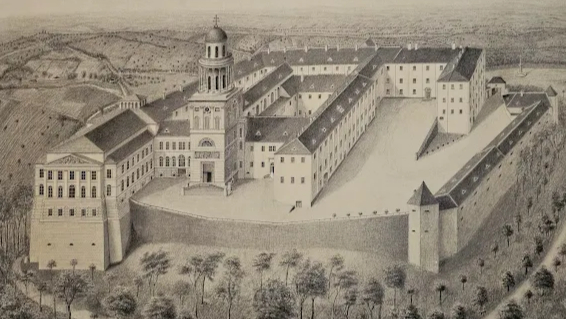
Pannonhalma Archabbey has been around for more than a thousand years, and its story starts in 996, when Prince Géza decided to invite Benedictine monks to settle on what was then called Márton-hegy the Hill of Saint Martin. He picked the spot not just for its peaceful setting, but also because it was believed to be the birthplace of Saint Martin of Tours. The monastery was built in his honor and quickly became the heart of the Benedictine order in Hungary. Géza’s son, King Stephen I who would later become Hungary’s first king and a saint himself supported the monastery from the start, donating land, privileges, and other resources. The first abbot was a monk named Astrik, also known as Anastasius, who played a key role in organizing the community. One of the treasures kept in the abbey’s library is the Tihany Charter from 1055, which contains the earliest surviving written words in Hungarian. It’s an incredible link to the country’s linguistic history. Over the centuries, the abbey saw its share of ups and downs. In 1137, the initial structures were destroyed, but they were soon rebuilt. In the early 1200s, the basilica’s columns and Gothic-style vaults were added, using parts of the earlier church. Later, under King Matthias in 1486, the place was reconstructed again in late Gothic style.
In 1541, the monastery was elevated to the rank of an archabbey. But that same period brought trouble: with the Ottoman Empire expanding into Europe, the monks had to fortify the buildings and, during many parts of the 16th and 17th centuries, abandon them altogether. When the area became more stable, reconstruction only got started. During the 1700s, under Archabbot Benedek Sajghó, the abbey saw major Baroque-style renovations. Many of the buildings and rich decorations you see today date back to that time. In the early 1800s, the abbey took on its current form, including the library and the tower built in a more classical style. Monasteries were required to demonstrate their “usefulness” to society during the Enlightenment, and many were only permitted to operate if they ran schools, hospitals, or charitable endeavors. By the 1860s, architect Ferenc Storno led another wave of renovation, especially in the basilica, carefully restoring and updating parts of the complex. The 20th century followed. After World War II, when Hungary became a communist state, religious institutions were heavily restricted. In 1950, the government confiscated the abbey’s properties and schools. The Benedictines weren’t allowed to reclaim them until the end of communist rule. In 1995, major restoration work took place to prepare for the abbey’s 1000th anniversary. A year later, in 1996, Pannonhalma and its surroundings were officially added to the UNESCO World Heritage List a recognition of its deep historical, architectural, and cultural importance.
Notable Visits and Moments
Through the years, Pannonhalma has welcomed quite a few significant figures. Moscow’s Patriarch Alexy II paid a visit in 1994. Pope John Paul II came in 1996. And in 2000, both Patriarch Bartholomew I of Constantinople and the 14th Dalai Lama, Tenzin Gyatso, made visits a rare moment bringing together different spiritual traditions. Also worth noting: Crown Princess Stephanie of Austria died here in 1945 and was buried at the abbey. In addition, in keeping with long-standing royal custom, Otto von Habsburg’s heart was buried here in 2011 as the current Crown Prince of Austria-Hungary. In 2005, a film was made about Archabbot Asztrik Várszegi, titled A közvetítő (The Mediator), offering a look into his life and leadership at the abbey.
Architecture of Benedictine Archabbey of Pannonhalma, Hungary

Architectural style: Baroque architecture, Gothic architecture
Perched on a hill above the town, the Pannonhalma Archabbey is more than a monastery it’s a living piece of Hungarian history, with its origins tracing all the way back to the year 996. Over the centuries, it’s grown into a sprawling complex that blends medieval architecture with Baroque flair and 19th-century Classicism.
Basilica and crypt
The present church of Pannonhalma, a crowning achievement of the early Gothic style, was built at the beginning of the 13th century during the reign of Abbot Uros, and was consecrated most likely in 1224. Recent archaeological findings under the floor level of the west end of the basilica date from the 11th century. The oldest segment currently seen in the basilica is the wall of the southern aisle. It is a relic of the second church that stood on the site in 1137, when Abbot Dávid was in power. It was built in the 12th century. During the archaeological excavations two walled-up gates were found in the sacristy. One of these could have presumably been the northern entrance of Abbot David’s church, while the other that of Abbot Uros’. Also found under the floor between the front altar and the sanctuary steps was a grave, most likely that of Abbot Uros. The current ceiling of the sanctuary, the eastern ends of the aisles, and the Saint Benedict chapel were all completed during the time that King Matthias extended the church. During the Turkish occupation the furnishings were entirely destroyed. The most significant renovation after the occupation started in the 1720s, under Archabbot Benedek Sajghó. Ferenc Storno was the last to undertake a major renovation of the church in the 1860s. At this time the main altar, the pulpit, the frescoes of the ceiling, and the upper-level stained glass window depicting Saint Martin were added.
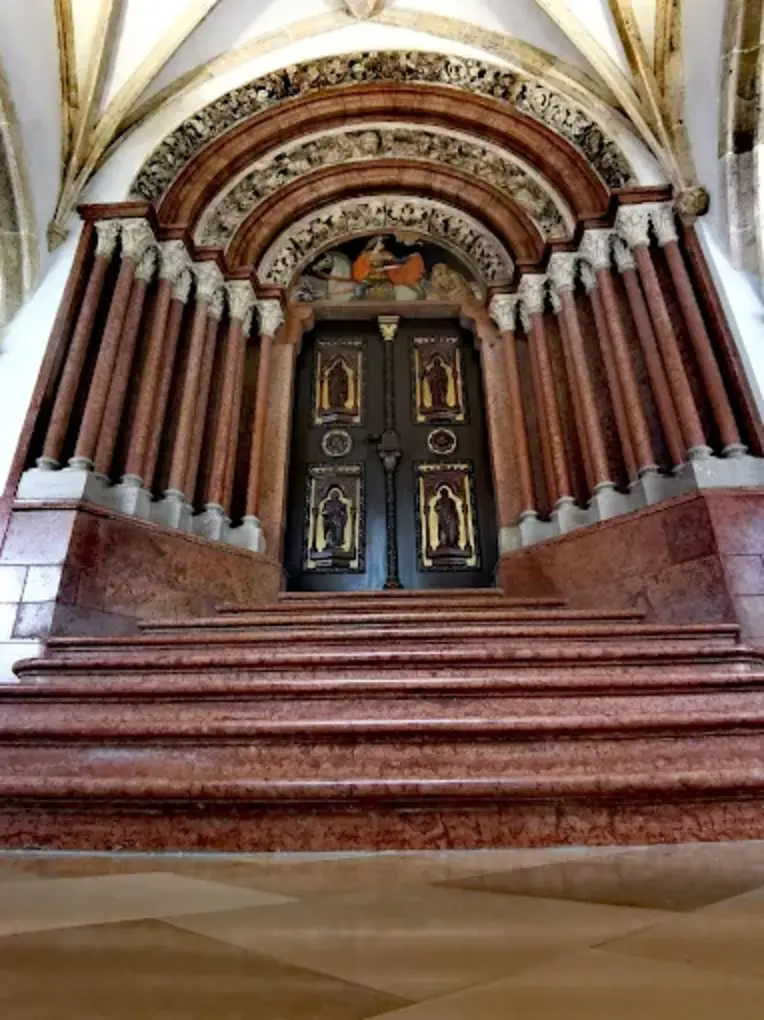
Porta Speciosa and the cloister
In the Middle Ages one of the main entrances to the church was the Porta Speciosa (ornate entrance). This portal leads to the church from the cloister (quadrum or quadratura) and it was crafted also in the 13th century. Pannonhalma was pretty much empty during the Renaissance, with only six or seven monks. Under King Matthias’ rule, in 1472, today’s cloister was created. The constructions were probably finished in 1486, as it is testified by the inscription on one of the cornerstones. Craftsmen from the Visegrád Royal Workshop of Construction probably carried out the work. The small inner garden surrounded by the cloister was also called Paradisum (Paradise) metaphorically creating an earthly imitation of Biblical Paradise. In medieval times mainly herbs were grown here so that those in need would recover the body in its wholeness and health as it was in Paradise.
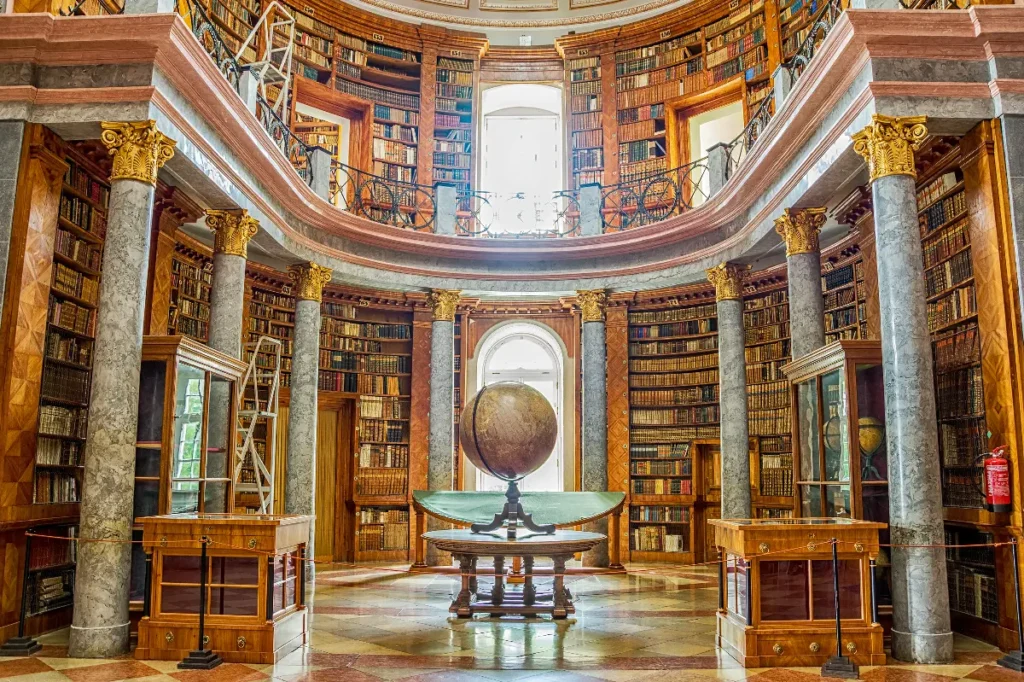
Library
The library was finished in the first third of the 19th century. Ferenc Engel designed and constructed the building’s longitudinal section in the 1820s. Later János Packh was commissioned with extending the edifice, and the oval hall is his work. The building’s interior was to be decorated by Vienna master Joseph Klieber. The four medieval university faculties of law, theology, medicine, and the arts are represented on the four sides of the oval hall’s ceiling. Since then, the library has added more items to its collection. Manuscripts from the time of Saint Laszlo have been catalogued in Pannonhalma. 400,000 volumes are kept in the collection. The library includes tens of thousands of 16th-century books, hundreds of manuscripts from before the invention of the printing press, a 13th-century Bible, and 19 codices. An infestation of drugstore beetles was discovered in a section of the library in 2025. The beetles had burrowed into book spines, leaving layers of dust on the shelves. In response, the abbey began a disinfection project for 100,000 of the books, placing crates of books in plastic bags from which the oxygen is removed. The process was anticipated to take six weeks, after which the books will be vacuumed and inspected for damage.
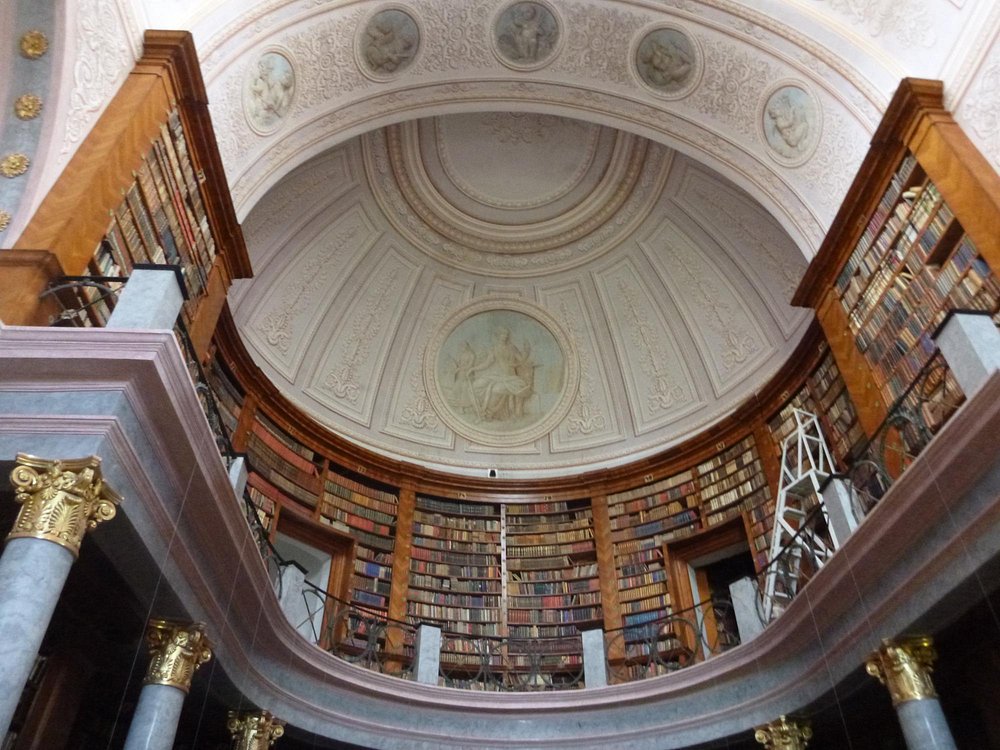
Baroque refectory
The monastery’s baroque elements were designed by Carmelite brother Atanaz Marton Witwer by Archabbot Benedek Sajghó (1722–1768). The construction of the two-story high, rectangular shaped hall with cavetto vault probably dates to the second half of the 1720s. The paintings (secco) on the walls were created between 1728 and 1730 by Davide Antonio Fossati, a Swiss artist who later settled in Venice. The secco on the ceiling depicts the apotheosis of King Saint Stephen. The offering of vinegar to Christ on the Cross, Jesus’ temptation in the desert, Daniel in the lions’ den, King Balthasar’s feast, Saint John the Baptist’s decapitation, and a scene from Saint Benedict’s life are the six well-known Biblical scenes on the side walls.
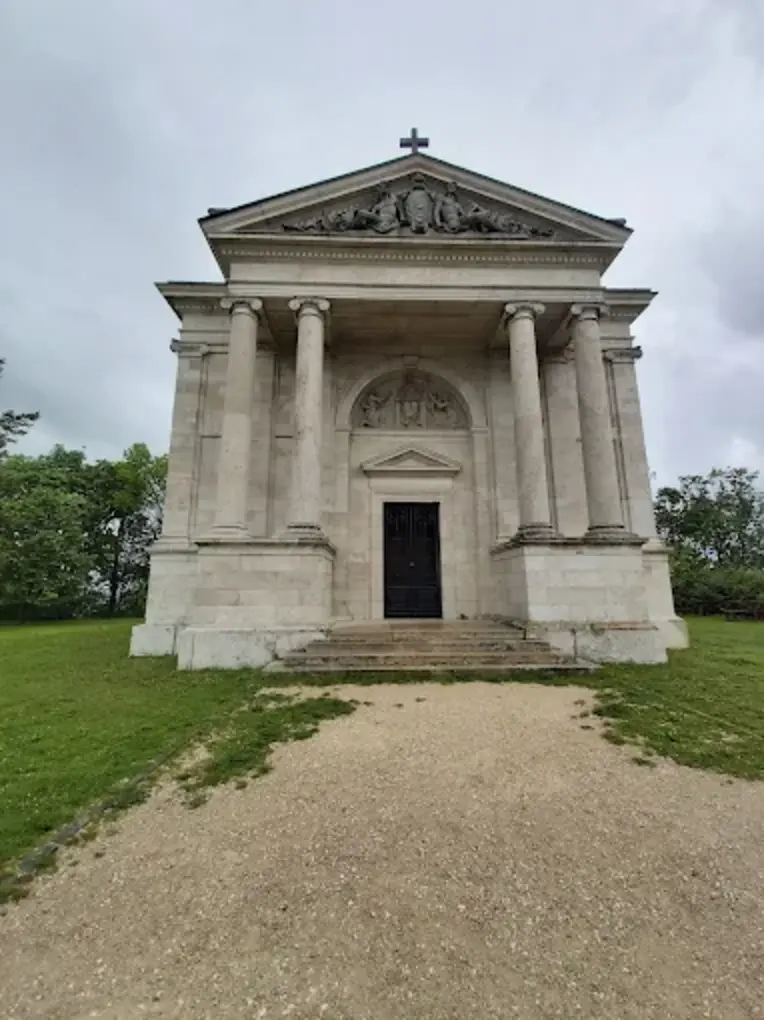
The Millennium Monument
In order to celebrate the millennium of the Magyars’ settlement in 896, seven monuments were erected in the Carpathian Mountain Basin in 1896. One of them can still be seen today in Pannonhalma. The edifice was originally covered by a 26-metre high, double-shell dome with a colossal brass relief on it representing the Hungarian royal crown. Due to its deterioration, however, the outer shell had to be dismantled in 1937–1938, and the building took its present form. Two windows shed light on the interior, a circular, undivided room covered by a low dome (i.e. the original inner shell). The unfinished fresco decorating the eastern wall is an allegorical vision of the Foundation of the Hungarian state and was painted by Vilmos Aba-Novák in 1938.

Our Lady Chapel
The construction of the Our Lady Chapel began in 1714. Originally it was a place of worship for the non-native population living in the vicinity of the abbey. The chapel, with its three baroque altars and small, 18th-century organ, was renovated in 1865, at which time the romantic ornamentation of the walls and the portal took place. The crypt beneath the church has served as the burial place of the monks for centuries. A wood-constructed lookout tower can be found near the Chapel.
Arboretum (Botanical Garden)
On the Archabbey’s land in 1830, there were as many as 80 different species of trees and bushes. It was through the design of Fábián Szeder in the 1840s that the current form of the arboretum took shape. Today the arboretum has more than 400 tree and bush species, many of which are rare species and varieties in Hungary.
Archives
The Pannonhalma Archives of the Benedictine Archabbey contains one of the richest and most valuable collections of documents from the first centuries of Hungarian statehood. It includes the monastery’s interpolated charter (1001–1002) from Saint Stephen, the founding charter of the Tihany Abbey (1055), the first known written text to include Hungarian words and phrases. The records of the medieval Pannonhalma, a monastery with the rights to issue official documents (locus authenticus), and the records of the Bakonybél, the Tihany and the Dömölk abbeys constitute separate entities. The archive collects documents from the archabbot’s office, the Theological School and the former Teacher Training School of the order, the former and current secondary schools, the dependent Benedictine houses, the finance offices of the Archabbey, and from the documentation of the parishes that belong to the so-called Territorial Abbey: a quasi-diocese under the authority of the Archabbey. Partially as deposit, partially as inheritance, the archives of the Guary, the Somogyi, the Chernel, the Kende, the Erdődy and the Lonyay families came into the collection. The amount of the archive’s holdings is 192 running metres.
The School
The abbey runs a boys’ high school, and it’s one of the most respected in the country. It’s been around in some form since forever, though it stopped for a while during the Turkish occupation. It reopened in 1690 and in 1939 it was turned into a school focused on Italian-style education lots of emphasis on language and culture. During the Communist regime, when most Catholic schools got shut down, this one somehow stayed open. Now it has about 300 students, and courses run between 4 to 6 years. There’s also a theological university inside the abbey named after Saint Gerard Sagredo.
Other Stuff Nearby
If you walk around the monastery grounds, you’ll find:
- The Cross’s Way (Baroque, 1724) Blessed Maurizio’s wooden lookout tower
- Vineyards and winemaking facilities
The Wine Story
Wine making started in the Pannonhalma-Sokoróalja region when Benedictine monks founded the monastery of Pannonhalma in 996. Social and political turmoil following World War II made it impossible to continue the centuries-old traditions, since both the properties and the winery were taken over by the Communist state. In the ensuing decades, monks living in Pannonhalma did not give up hope of resuscitating their wine-making traditions. Since the fall of Communism, the monks have revived the viticultural traditions and the wineries. In 2000, the abbey repurchased vineyards that had been confiscated by the Communists and began replanting grape vines in the same year. The winery is situated on a 2000 m2 plot with a capacity of 3000 hls. The main grape varieties are Rhine Riesling, Sauvignon blanc, Gewürztraminer, Welschriesling, Ezerjó and Sárfehér. They have also planted international varieties of Chardonnay, Pinot blanc, Pinot noir, Merlot, and Cabernet Franc. The first harvest occurred in the fall of 2003, and they currently have 37 hectares of newly planted vines.
Feast Day
Feast Day : 11 November
The main feast day of the Benedictine Archabbey of Pannonhalma is November 11th, which honors Saint Martin of Tours, the abbey’s patron saint. Additionally, August 20th is also an important day celebrated there, as it is the November, the first king of Hungary and a key historical figure connected to the abbey.
Church Mass Timing
Monday to Saturday : 04:30 PM
Sunday : 09:00 AM , 11:00 AM , 04:30 PM
Church Opening Time:
Monday : 09:00 am – 4:00 pm
Tuesday to Thursday : 11:00 am – 4:00 pm
Friday : 01:30 pm – 5:00 pm
Saturday : 01:30 pm – 5:30 pm
Sunday :11:30 am – 05:00 pm.
Contact Info
Address : Pannonhalma Archabbey
Pannonhalma, Vár 1, 9090 Hungary.
Phone : +36 96 570 191
Accommodations
Connectivities
Airway
Benedictine Archabbey of Pannonhalma, Hungary, to Václav Havel Airport Prague, distance 38 min (18.3 km) via Evropská.
Railway
Benedictine Archabbey of Pannonhalma, Hungary, to The Main Train Station of Prague, distance between 7 min (2.0 km) via Vinohradská.


